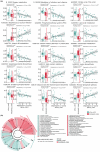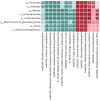Characterization of Gut Microbiome Composition in Depression and Completed Suicide
- PMID: 40430019
- PMCID: PMC12112742
- DOI: 10.3390/ijms26104880
Characterization of Gut Microbiome Composition in Depression and Completed Suicide
Abstract
Growing evidence supports a bidirectional relationship between the gut microbiome and mental health. This study investigated the association between gut microbiota, depression, and suicidal behavior by analyzing fecal samples from 35 individuals with varying depression levels and 36 completed suicide cases. Standardized psychometric assessments were used for depression evaluation. Analysis revealed significant taxonomic differences between groups, with increased abundance of Firmicutes, Clostridia, Lachnospiraceae, Blautia, and Dorea in suicide cases, which also positively correlated with depression severity. Metabolic pathway analysis demonstrated a notable dichotomy: suicide cases showed elevated pathways related to infection processes, inflammation, and antibiotic resistance, while the control group exhibited higher energy metabolism and vitamin synthesis pathways. The findings establish specific microbiome profiles associated with both depression symptoms and suicidal behavior, suggesting that gut dysbiosis may influence mental health through altered energy metabolism and inflammatory processes, potentially offering new perspectives for diagnostic and therapeutic approaches.
Keywords: Firmicutes; Lachnospiraceae; depression; energy metabolism; gut microbiome; gut–brain axis; inflammation; mental health; metabolic pathways; suicide.
Conflict of interest statement
The authors declare no conflicts of interest. The funders had no role in the design of the study; in the collection, analyses, or interpretation of data; in the writing of the manuscript; or in the decision to publish the results.
Figures






References
-
- Xie P. Alterating the Gut Microbiome by Microbiota Transplantation from Depressed Patients into Germ-Free Mice Results in Depressive-like Behaviors Through a Pathway Mediated by the Host’s Metabolism. Eur. Neuropsychopharmacol. 2017;27:S478–S479. doi: 10.1016/j.euroneuro.2016.09.562. - DOI
-
- Chung Y.-C.E., Chen H.-C., Chou H.-C.L., Chen I.-M., Lee M.-S., Chuang L.-C., Liu Y.-W., Lu M.-L., Chen C.-H., Wu C.-S., et al. Exploration of microbiota targets for major depressive disorder and mood related traits. J. Psychiatr. Res. 2019;111:74–82. doi: 10.1016/j.jpsychires.2019.01.016. - DOI - PubMed
MeSH terms
Grants and funding
LinkOut - more resources
Full Text Sources
Medical

